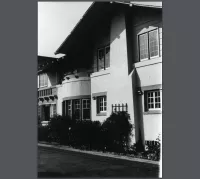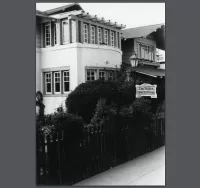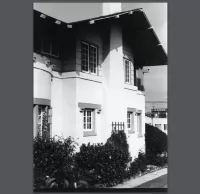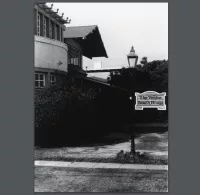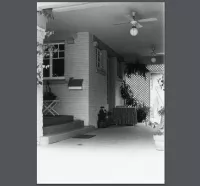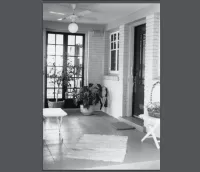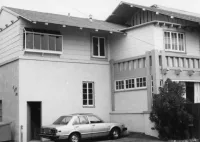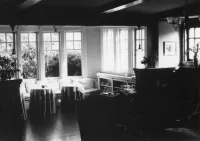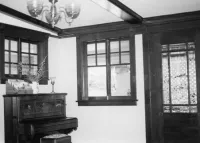Share what you know,
and discover more.
Share what you know,
and discover more.
Mar 03, 2022
Mar 03, 2022
15 30th Avenue, Venice, CA, USA
The Venice Beach HousePosted Date
Mar 15, 2022
Historical Record Date
Mar 03, 2022
Source Name
Fodors Travel
Delete Story
Are you sure you want to delete this story?
Jul 17, 1986
Jul 17, 1986
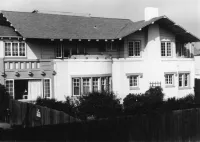
-

- Dave D
National Register of Historic Places - The Warren Wilson Beach House
Statement of Significance: Constructed in 1911 by the owner and editor of the Los Angeles Daily Journal, the Warren Wilson Beach House is significant for its fine Craftsman architecture, its connections with persons significant to Venice and Los Angeles history, and its illustration of the broad patterns of history representing beach area settlement patterns and early Twentieth-century vacation customs. Although there are other Craftsman Bungalows in Venice, particularly along the streets to the northeast, no other single-family home is as large or as fine an example of Craftsman architecture as this one. As a newspaperman, Warren Wilson was considered well ahead of his time. He was known for his strongly worded editorials which demanded the vote for women, campaigned for improvements in the quality of California justice, decried racial prejudice, and lobbied for reform in the telegraph industry. When he built this large house for his wife and eight children, it stood alone among the sand dunes, several blocks south of Venice's new cultural center. Venice is a unique and special city. Founded in 1904-05 by tobacco tycoon. Abbot Kinney, it was modeled after Venice, Italy, with its canals, elaborate Italian Renaissance architecture, and gondolas. The Wilson family had close ties with the Abbot Kinney family as two of Warren Wilson’s daughters married two of Kinney's sons. The Wilson Beach House and the Kinney House (now demolished) were the center of Venice social activity. With Warren Wilson's strong opinions concerning justice, women's rights, and racial prejudice, and Abbot Kinney's firm ideas about bringing culture and education to America, the house often provided a forum for influential Los Angeles businessmen and politicians to discuss future plans for the Los Angeles area. The prime years of significance of the house were also the prime years of significance for Venice and for Warren Wilson. After Abbot Kinney died in 1920, Venice never was the same. The community changed dramatically over the years, and the Venice Beach House, now a bed-and-breakfast inn, is a visual reminder of Venice as it was during its heyday as a unique and special beach community. Warren Wilson built the Venice Beach House in 1911 for his wife, eight children and their families and friends. As the editor and owner of the Los Angeles Daily Journal, he sometimes felt the need to escape the daily pressures of his editorial crusades and retreated to this house. At the time it stood along among the sand dunes, south of the commercial center of Venice. He had purchased the land in 1908 at a time when Abbot Kinney was selling land in Venice for as much as $2700 a lot (more than in the new subdivision of Beverly Hills). In Los Angeles Wilson was writing strong editorials which demanded the vote for women, decried racial prejudice, and influenced improvements in the quality of California justice system. When the Titanic sank on April 14, 1912, Wilson's newspaper erroneously reported "All Passengers Saved", and Wilson blamed this tragic error on America’s infant telegraph monopoly, whose greedy operators had withheld the truth while selling their news to the highest bidder. Several blistering editorials were written by Wilson for reform of the telegraph industry. The Wilsons owned the house until 1945, using it as a family retreat. On July 4, 1905, tobacco tycoon. Abbot Kinney officially opened the city of Venice, California, before a crowd of over 60,000 people, one of the largest crowds ever generated in Southern California at that time. Kinney modeled his city after Venice, Italy, building a system of canals and Italian Renaissance commercial buildings, and importing gondolas and gondoliers from Italy. He envisioned Venice as the cultural and educational center of the West. However, culture was not what the visitors wanted, and the city soon became a seaside resort and housing development. Venice was an immediate hit and Kinney was able to get high prices for his lots. A 1914 guide to beach cities listed Venice as the playground of the Pacific and boasted that the city had larger and better amusements than any other resort with the exception of Coney Island. Venice was a 25 cent railroad trip from Los Angeles and offered band concerts on the pier, dances, 10 cent camel rides, hootchy-kootchy shows, airplane barnstorming, road races, a miniature railroad, and other amusements. Venice enjoyed its best years 1905 to 1920, when Abbott Kinney died. Much of the optimism and spirit of Venice residents died with him. A major local government scandal in 1922 led to the move by Venice residences to annex as a part of the City of Los Angeles in 1925. In spite of this, Venice still had a lack of city services and deteriorating. On December 18, 1929, oil was discovered in Venice and the city became covered with oil derricks, debris, and oil odors. Now the evidence of the oil industry is gone and the city is once again known for its unique carnival atmosphere and as the home of highly individualistic people. The Warren Wilson Beach House, now called the Venice Beach House, is a fine example of Craftsman-style single family home and stands out among the residences of the city. For these reasons and for its connections with Warren Wilson and Abbot Kinney, both significant persons in the history of Venice and Los Angeles County, this building is worthy of listing in the National Register of Historic Places.
National Register of Historic Places - The Warren Wilson Beach House
Statement of Significance: Constructed in 1911 by the owner and editor of the Los Angeles Daily Journal, the Warren Wilson Beach House is significant for its fine Craftsman architecture, its connections with persons significant to Venice and Los Angeles history, and its illustration of the broad patterns of history representing beach area settlement patterns and early Twentieth-century vacation customs. Although there are other Craftsman Bungalows in Venice, particularly along the streets to the northeast, no other single-family home is as large or as fine an example of Craftsman architecture as this one. As a newspaperman, Warren Wilson was considered well ahead of his time. He was known for his strongly worded editorials which demanded the vote for women, campaigned for improvements in the quality of California justice, decried racial prejudice, and lobbied for reform in the telegraph industry. When he built this large house for his wife and eight children, it stood alone among the sand dunes, several blocks south of Venice's new cultural center. Venice is a unique and special city. Founded in 1904-05 by tobacco tycoon. Abbot Kinney, it was modeled after Venice, Italy, with its canals, elaborate Italian Renaissance architecture, and gondolas. The Wilson family had close ties with the Abbot Kinney family as two of Warren Wilson’s daughters married two of Kinney's sons. The Wilson Beach House and the Kinney House (now demolished) were the center of Venice social activity. With Warren Wilson's strong opinions concerning justice, women's rights, and racial prejudice, and Abbot Kinney's firm ideas about bringing culture and education to America, the house often provided a forum for influential Los Angeles businessmen and politicians to discuss future plans for the Los Angeles area. The prime years of significance of the house were also the prime years of significance for Venice and for Warren Wilson. After Abbot Kinney died in 1920, Venice never was the same. The community changed dramatically over the years, and the Venice Beach House, now a bed-and-breakfast inn, is a visual reminder of Venice as it was during its heyday as a unique and special beach community. Warren Wilson built the Venice Beach House in 1911 for his wife, eight children and their families and friends. As the editor and owner of the Los Angeles Daily Journal, he sometimes felt the need to escape the daily pressures of his editorial crusades and retreated to this house. At the time it stood along among the sand dunes, south of the commercial center of Venice. He had purchased the land in 1908 at a time when Abbot Kinney was selling land in Venice for as much as $2700 a lot (more than in the new subdivision of Beverly Hills). In Los Angeles Wilson was writing strong editorials which demanded the vote for women, decried racial prejudice, and influenced improvements in the quality of California justice system. When the Titanic sank on April 14, 1912, Wilson's newspaper erroneously reported "All Passengers Saved", and Wilson blamed this tragic error on America’s infant telegraph monopoly, whose greedy operators had withheld the truth while selling their news to the highest bidder. Several blistering editorials were written by Wilson for reform of the telegraph industry. The Wilsons owned the house until 1945, using it as a family retreat. On July 4, 1905, tobacco tycoon. Abbot Kinney officially opened the city of Venice, California, before a crowd of over 60,000 people, one of the largest crowds ever generated in Southern California at that time. Kinney modeled his city after Venice, Italy, building a system of canals and Italian Renaissance commercial buildings, and importing gondolas and gondoliers from Italy. He envisioned Venice as the cultural and educational center of the West. However, culture was not what the visitors wanted, and the city soon became a seaside resort and housing development. Venice was an immediate hit and Kinney was able to get high prices for his lots. A 1914 guide to beach cities listed Venice as the playground of the Pacific and boasted that the city had larger and better amusements than any other resort with the exception of Coney Island. Venice was a 25 cent railroad trip from Los Angeles and offered band concerts on the pier, dances, 10 cent camel rides, hootchy-kootchy shows, airplane barnstorming, road races, a miniature railroad, and other amusements. Venice enjoyed its best years 1905 to 1920, when Abbott Kinney died. Much of the optimism and spirit of Venice residents died with him. A major local government scandal in 1922 led to the move by Venice residences to annex as a part of the City of Los Angeles in 1925. In spite of this, Venice still had a lack of city services and deteriorating. On December 18, 1929, oil was discovered in Venice and the city became covered with oil derricks, debris, and oil odors. Now the evidence of the oil industry is gone and the city is once again known for its unique carnival atmosphere and as the home of highly individualistic people. The Warren Wilson Beach House, now called the Venice Beach House, is a fine example of Craftsman-style single family home and stands out among the residences of the city. For these reasons and for its connections with Warren Wilson and Abbot Kinney, both significant persons in the history of Venice and Los Angeles County, this building is worthy of listing in the National Register of Historic Places.
National Register of Historic Places - The Warren Wilson Beach House
Statement of Significance:Constructed in 1911 by the owner and editor of the Los Angeles Daily Journal, the Warren Wilson Beach House is significant for its fine Craftsman architecture, its connections with persons significant to Venice and Los Angeles history, and its illustration of the broad patterns of history representing beach area settlement patterns and early Twentieth-century vacation customs. Although there are other Craftsman Bungalows in Venice, particularly along the streets to the northeast, no other single-family home is as large or as fine an example of Craftsman architecture as this one. As a newspaperman, Warren Wilson was considered well ahead of his time. He was known for his strongly worded editorials which demanded the vote for women, campaigned for improvements in the quality of California justice, decried racial prejudice, and lobbied for reform in the telegraph industry. When he built this large house for his wife and eight children, it stood alone among the sand dunes, several blocks south of Venice's new cultural center. Venice is a unique and special city. Founded in 1904-05 by tobacco tycoon. Abbot Kinney, it was modeled after Venice, Italy, with its canals, elaborate Italian Renaissance architecture, and gondolas. The Wilson family had close ties with the Abbot Kinney family as two of Warren Wilson’s daughters married two of Kinney's sons. The Wilson Beach House and the Kinney House (now demolished) were the center of Venice social activity. With Warren Wilson's strong opinions concerning justice, women's rights, and racial prejudice, and Abbot Kinney's firm ideas about bringing culture and education to America, the house often provided a forum for influential Los Angeles businessmen and politicians to discuss future plans for the Los Angeles area. The prime years of significance of the house were also the prime years of significance for Venice and for Warren Wilson. After Abbot Kinney died in 1920, Venice never was the same. The community changed dramatically over the years, and the Venice Beach House, now a bed-and-breakfast inn, is a visual reminder of Venice as it was during its heyday as a unique and special beach community.
Warren Wilson built the Venice Beach House in 1911 for his wife, eight children and their families and friends. As the editor and owner of the Los Angeles Daily Journal, he sometimes felt the need to escape the daily pressures of his editorial crusades and retreated to this house. At the time it stood along among the sand dunes, south of the commercial center of Venice. He had purchased the land in 1908 at a time when Abbot Kinney was selling land in Venice for as much as $2700 a lot (more than in the new subdivision of Beverly Hills). In Los Angeles Wilson was writing strong editorials which demanded the vote for women, decried racial prejudice, and influenced improvements in the quality of California justice system. When the Titanic sank on April 14, 1912, Wilson's newspaper erroneously reported "All Passengers Saved", and Wilson blamed this tragic error on America’s infant telegraph monopoly, whose greedy operators had withheld the truth while selling their news to the highest bidder. Several blistering editorials were written by Wilson for reform of the telegraph industry. The Wilsons owned the house until 1945, using it as a family retreat.
On July 4, 1905, tobacco tycoon. Abbot Kinney officially opened the city of Venice, California, before a crowd of over 60,000 people, one of the largest crowds ever generated in Southern California at that time. Kinney modeled his city after Venice, Italy, building a system of canals and Italian Renaissance commercial buildings, and importing gondolas and gondoliers from Italy. He envisioned Venice as the cultural and educational center of the West. However, culture was not what the visitors wanted, and the city soon became a seaside resort and housing development. Venice was an immediate hit and Kinney was able to get high prices for his lots. A 1914 guide to beach cities listed Venice as the playground of the Pacific and boasted that the city had larger and better amusements than any other resort with the exception of Coney Island. Venice was a 25 cent railroad trip from Los Angeles and offered band concerts on the pier, dances, 10 cent camel rides, hootchy-kootchy shows, airplane barnstorming, road races, a miniature railroad, and other amusements. Venice enjoyed its best years 1905 to 1920, when Abbott Kinney died. Much of the optimism and spirit of Venice residents died with him. A major local government scandal in 1922 led to the move by Venice residences to annex as a part of the City of Los Angeles in 1925. In spite of this, Venice still had a lack of city services and deteriorating. On December 18, 1929, oil was discovered in Venice and the city became covered with oil derricks, debris, and oil odors. Now the evidence of the oil industry is gone and the city is once again known for its unique carnival atmosphere and as the home of highly individualistic people.
The Warren Wilson Beach House, now called the Venice Beach House, is a fine example of Craftsman-style single family home and stands out among the residences of the city. For these reasons and for its connections with Warren Wilson and Abbot Kinney, both significant persons in the history of Venice and Los Angeles County, this building is worthy of listing in the National Register of Historic Places.
Posted Date
Mar 15, 2022
Historical Record Date
Jul 17, 1986
Source Name
United States Department of the Interior - National Park Service
Source Website
Delete Story
Are you sure you want to delete this story?



